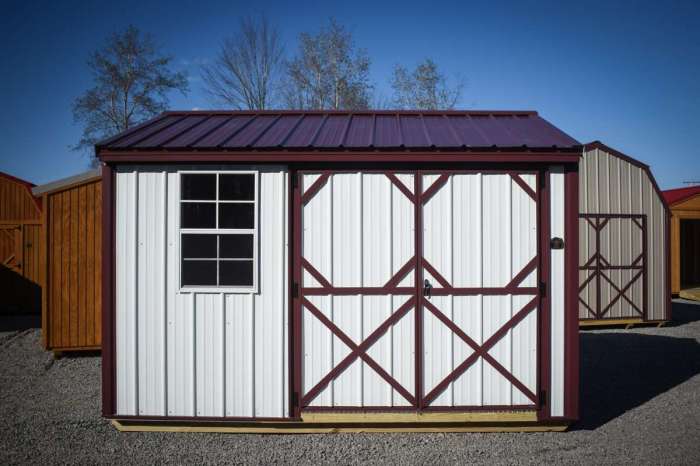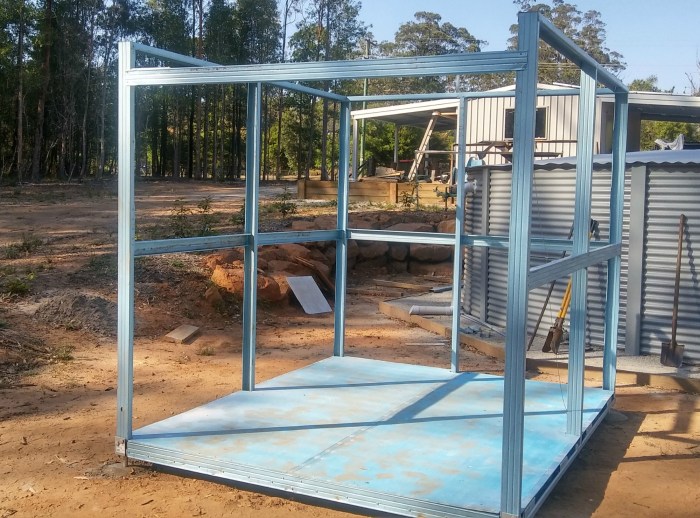DIY Metal Shed: Building your own metal shed is a rewarding project that can provide you with a durable and versatile storage solution. Whether you need a place to store garden tools, equipment, or simply want extra space, a metal shed offers numerous advantages over traditional wooden structures. This comprehensive guide will walk you through every step of the process, from planning and choosing the right kit to assembly, customization, and maintenance.
From choosing the right metal shed kit to mastering the assembly process, this guide will provide you with the knowledge and confidence to create a sturdy and functional shed that meets your specific needs. We’ll cover everything from preparing the site and choosing the right foundation to tackling common challenges and ensuring long-term durability.
Cost Considerations

Building a metal shed can be a cost-effective way to add storage space to your property. However, the overall cost will vary depending on the size, features, and materials you choose. It’s crucial to factor in all expenses to create a realistic budget and avoid unexpected costs.
Metal Shed Kit Costs
Metal shed kits offer a convenient and often cost-effective way to build a shed. The cost of these kits can vary significantly based on factors like size, style, and features.
- Size: Larger sheds naturally cost more due to the increased amount of materials required. A small 8×10 shed kit might cost around $1,000, while a larger 12×16 shed kit could cost $2,500 or more.
- Style: Sheds with more complex designs, such as those with windows, doors, or additional features, will typically be more expensive. Simple, basic sheds tend to be more affordable.
- Features: Features like pre-painted panels, reinforced doors, or extra bracing can increase the cost of a shed kit. Choosing a basic kit with minimal features can help save money.
- Brand: Different manufacturers offer kits at varying price points. Researching and comparing prices from reputable brands can help you find the best value for your budget.
Creative Uses for a Metal Shed

Metal sheds are known for their durability and versatility, but they offer more than just storage space. With a little creativity, you can transform a metal shed into a functional and stylish addition to your property, serving various purposes beyond the ordinary.
Converting a Metal Shed into a Workshop, Diy metal shed
A metal shed’s sturdy construction and ample space make it ideal for setting up a workshop. The metal exterior provides a durable surface that can withstand the wear and tear of tools and equipment, while the interior can be customized to suit your specific needs.
Design Inspiration for a Workshop Shed
- Install workbenches along the walls, maximizing space and providing dedicated work areas.
- Add shelves and storage cabinets to keep tools and supplies organized.
- Install a ventilation system to ensure proper air circulation and prevent dust buildup.
- Consider adding a skylight for natural light, enhancing visibility and creating a brighter work environment.
- Paint the interior walls a light color to reflect light and create a more spacious feel.
Transforming a Metal Shed into a Studio
A metal shed can be converted into a dedicated art studio, providing a quiet and inspiring space for creative pursuits. The shed’s solid walls offer sound insulation, minimizing distractions and creating a focused environment.
Design Inspiration for a Studio Shed
- Paint the interior walls in neutral colors to create a calming and uncluttered backdrop for your artwork.
- Install ample lighting, including natural light through windows or skylights, to illuminate your work area.
- Create dedicated storage for art supplies and equipment, keeping the studio organized and efficient.
- Consider adding a small kitchenette or coffee bar for refreshments and a comfortable work environment.
- Add a comfortable seating area for contemplation and relaxation, fostering creativity and inspiration.
Creating a Home Office in a Metal Shed
For those seeking a dedicated work space away from the distractions of home, a metal shed can be transformed into a functional and stylish home office. The shed’s privacy and quiet environment provide a conducive setting for focused work.
Design Inspiration for a Home Office Shed
- Install a desk with ample workspace and comfortable seating.
- Add shelves and storage solutions to organize documents, files, and office supplies.
- Ensure adequate lighting, both natural and artificial, to create a well-lit and comfortable work environment.
- Consider adding a small refrigerator or microwave for convenience and refreshments.
- Decorate the space with inspiring artwork or plants to create a positive and stimulating work atmosphere.
Utilizing a Metal Shed as a Guest Room
A metal shed can be converted into a comfortable and cozy guest room, offering a private and independent space for visitors. The shed’s durability and insulation provide a secure and comfortable environment for overnight stays.
Design Inspiration for a Guest Room Shed
- Install a comfortable bed with appropriate bedding and linens.
- Add a small dresser or closet for storing guest belongings.
- Include a bedside table with a lamp for reading and ambiance.
- Ensure adequate lighting, both natural and artificial, for a comfortable and inviting space.
- Decorate the space with cozy touches, such as throw pillows, blankets, and artwork, to create a warm and welcoming atmosphere.
Integrating a Metal Shed into Your Landscaping Design
A metal shed can seamlessly blend into your landscape design, enhancing the overall aesthetic appeal of your property.
Ideas for Landscaping with a Metal Shed
- Choose a shed color that complements the existing color scheme of your home and landscape.
- Plant climbing vines or flowering shrubs around the shed to create a natural and visually appealing backdrop.
- Place the shed strategically to maximize its visibility and create a focal point in your landscape.
- Use landscaping elements such as pathways, stone borders, or decorative lighting to integrate the shed into your overall design.
- Consider adding a patio or seating area near the shed to create a relaxing and inviting outdoor space.
Troubleshooting and Repairs: Diy Metal Shed
Metal sheds, while durable, can sometimes experience issues that require attention. Knowing how to troubleshoot and repair common problems will help extend the life of your shed and keep it in top condition.
Identifying Common Problems
Understanding the potential issues can help you address them promptly. Here are some common problems that may arise:
- Leaks: Leaks can occur at seams, around doors and windows, or due to damage to the metal panels.
- Rust: Exposure to moisture and weather can cause rust, especially in areas where the protective coating has been compromised.
- Damaged Panels: Impacts, scratches, or dents can damage the metal panels, affecting both appearance and functionality.
- Door and Window Issues: Doors and windows may become misaligned, stick, or fail to open and close properly.
Troubleshooting and Repairing Leaks
Leaks are a common issue with metal sheds. Here’s how to troubleshoot and repair them:
- Identify the Source: Carefully inspect the shed’s interior and exterior to pinpoint the exact location of the leak. Look for water stains, dripping, or visible gaps.
- Seal Seams: Apply a high-quality sealant to any seams where leaks are occurring. Use a sealant specifically designed for metal roofs and walls.
- Repair Damaged Panels: If the leak is due to a damaged panel, you may need to replace it. Use metal shears to cut out the damaged section and replace it with a new piece of metal.
- Caulk Around Doors and Windows: Check the caulking around doors and windows for cracks or gaps. Apply a new bead of sealant if necessary.
Addressing Rust
Rust can weaken the metal and affect its appearance. Here’s how to tackle rust:
- Clean the Affected Area: Use a wire brush or sandpaper to remove loose rust and debris.
- Apply Rust Converter: Apply a rust converter to neutralize the existing rust and prevent further corrosion. This will create a stable surface for paint.
- Prime and Paint: After the rust converter has dried, apply a primer and then a high-quality metal paint to protect the surface from future rust.
Repairing Damaged Panels
Damaged panels can be repaired or replaced:
- Minor Dents: For minor dents, try using a rubber mallet or a dent puller to gently push the metal back into shape.
- Major Damage: For significant damage, you may need to replace the entire panel. Use metal shears to cut out the damaged section and replace it with a new panel.
Sourcing Replacement Parts
When replacing panels or other components, you’ll need to find suitable replacements. Here are some tips:
- Contact the Manufacturer: The manufacturer of your shed is often the best source for replacement parts. They can provide exact matches for your shed’s model.
- Check Online Retailers: Online retailers specializing in shed supplies can offer a wide selection of replacement parts.
- Local Hardware Stores: Local hardware stores may carry basic replacement parts for metal sheds.
Working with Metal Repair Techniques
Repairing metal sheds often involves working with metal. Here are some helpful techniques:
- Cutting Metal: Use metal shears or a jigsaw with a metal-cutting blade for precise cuts. Wear safety glasses and gloves.
- Drilling Metal: Use a drill bit specifically designed for metal to prevent slippage and damage. Apply cutting oil to reduce friction and heat.
- Fastening Metal: Use self-tapping screws or rivets to securely attach metal panels or components.
Frequently Asked Questions
- How often should I inspect my metal shed for repairs? It’s recommended to inspect your shed at least twice a year, especially after harsh weather conditions.
- What type of sealant is best for metal sheds? Look for a sealant specifically designed for metal roofs and walls, as it will provide better adhesion and weather resistance.
- Can I use regular paint on my metal shed? While you can use regular paint, metal paint is specifically formulated for metal surfaces and provides better protection against rust and corrosion.
- How do I prevent rust on my metal shed? Regular cleaning and maintenance, along with applying a protective coating, can help prevent rust.
Building a DIY metal shed is a project that can be both challenging and rewarding. By carefully planning, selecting the right materials, and following the steps Artikeld in this guide, you can create a durable and versatile storage solution that will serve you well for years to come. Remember to prioritize safety, use quality materials, and take pride in your handiwork. With a little effort and dedication, you’ll have a metal shed that you can be proud of.
Building a DIY metal shed is a great way to add extra storage space to your property. While you’re working on the project, it’s important to remember that proper ventilation is key. This is especially true if you plan to store items that might be susceptible to moisture damage, such as old photos or important documents. In the same way that you might need to consider ventilation for your shed, it’s also crucial to understand the importance of proper breathing techniques, especially for those with respiratory conditions.
For example, salbutamol tablets are often used to help manage asthma symptoms and ensure proper airflow. Once your shed is complete, you’ll have a safe and dry place to store your belongings, giving you peace of mind knowing they are protected from the elements.
